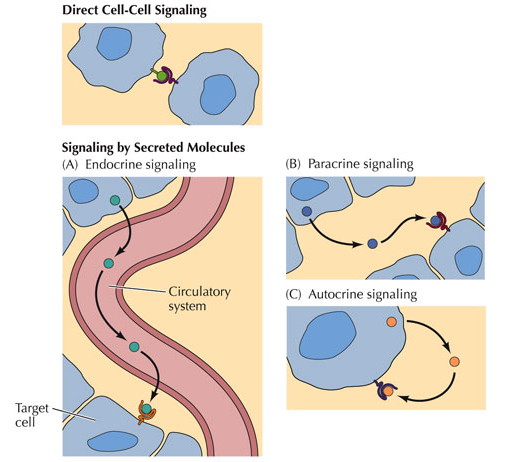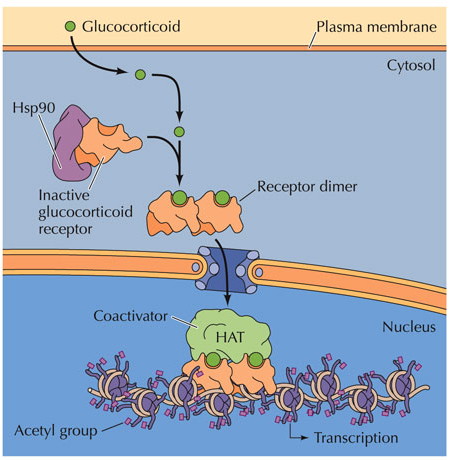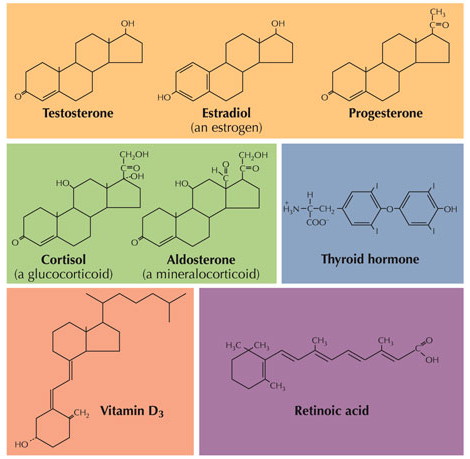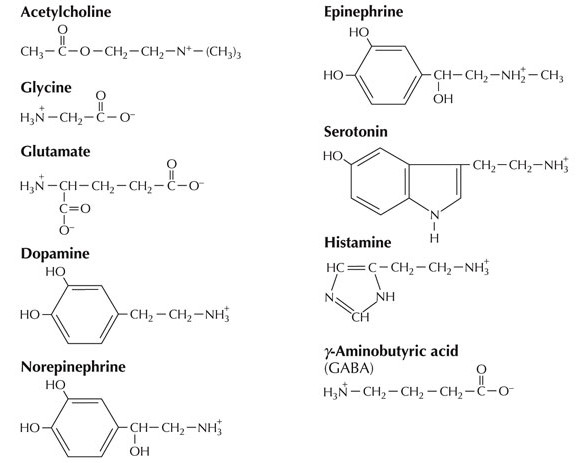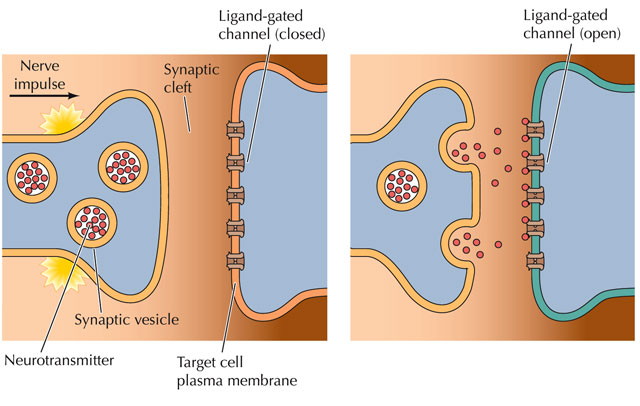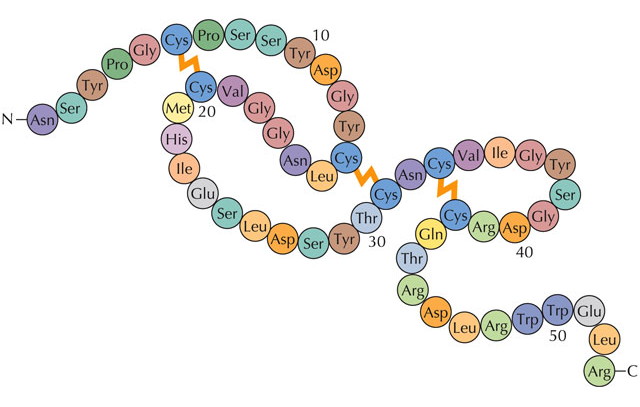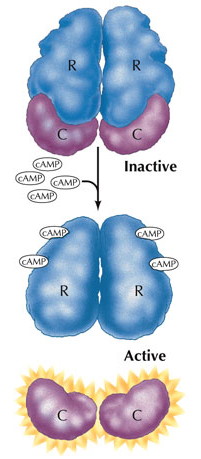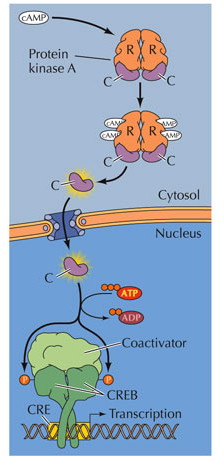|
Cells use various
methods of communicating with each other in the process
called cell signaling. Signal molecules are released
by signaling cells and bind to a receptor on or in
the target cell.
- Direct
Cell-Cell Signaling: Cell can communicate by
way of direct connection between the cells. This type
of direct cell to cell signaling as seen in some
communication between adjacent cells during embryonic
development.
|
|
- Signaling
by Secreted Molecules: Cells often
communicate with other cells by secreting a molecule
that travels to the target cell.
- Endocrine
Signaling: Signal molecules called hormones
are released from the endocrine organ and travel
through the circulatory system to the target organ.
Endocrine organs include the pituitary, thyroid,
parathyroids, pancreas, adrenal glands, gonads, and
many others.
- Paracrine
Signaling: Some signal molecules travel to
local target organs (not by way of the circulatory
system). A familiar example of this type of signal
molecule is the neurotransmitters that cross the
synapse in nervous tissue.
- Autocrine Signaling: Some
signal molecules travel very locally, that is, the
secreting cell and target cell are the same. An
example is the proliferation of T cells of the
immune system which is induced by antigens released
by T cells.
|
|
- Some Examples of Animal Signaling
Molecules
- Steroid Hormones: Steroid
hormones
are examples of signal molecules that can cross the
cell membrane of the target cell and then bind to a
receptor in the cell (they are small, hydrophobic
molecules). Steroids bind to a receptor molecule in
the cells that then interacts directly with the DNA
to activate transcription. Steroids are made from
cholesterol and include testosterone, estrogen, and
progesterone (sex steroids, made chiefly by the
gonads) and the corticosteroids (made chiefly by the
adrenal gland). (Thyroid hormone, vitamin D, and
retinoic acid are not actual steroids but function
similarly.)
|
- NO:
Nitric oxide (NO) in important in certain paracrine
signaling pathways. NO is involved in the signaling
that results in blood vessel dilation. In response
to neurotransmitters, endothelial cells of vessels
synthesize NO (nitric oxide synthetase is the enzyme
that uses arginine as a substrate to form nitric
oxide). NO travels to and enters nearby smooth
muscle cells where it activates guanylyl cyclase
which synthesizes cyclic GMP (cGMP, a second
messenger molecule). This relaxes the smooth muscle,
dilating the vessel. (Nitroglycerin, used in
treating heart disease, is converted to NO.) NO is
only a paracrine signaler because of its half-life
of only a few seconds.
|
- Neurotransmitters: These
molecules
move
from
a
neuron
to another neuron (or muscle), diffuse across the
synaptic cleft and bind to receptor on the surface
of the target. They include acetylcholine, dopamine,
epinephrine (it also functions as a hormone secreted
by the adrenal gland and is also called adrenaline),
serotonin, histamine, glutamate, glycine, and GABA.
(These are hydrophilic so cannot cross the
membrane.) The binding opens ion channels on the
target cell initiating a nerve impulse.
|
- Peptides: Numerous
signaling
molecules
are
peptides
(a
few to more than 100 amino acids) including insulin
and glucagon made by the pancreas and the hormones
of the pituitary gland (including growth hormone and
FSH). These also cannot cross the cell membrane so
bind to receptors on the cell surface.
|
- Eicosanoids
(like prostaglandins): These
signaling
molecules
are
lipids that bind to cell surface receptors and are
paracrine signalers. They include prostaglandins,
some of which which promote inflammation. One enzyme
in the synthesis of prostaglandins is cyclooxygenase
(COX). This enzyme is inhibited by nonsteroidal
anti-inflammatory drugs (NSAIDs) like aspirin. There
are 2 forms of COX: COX-1 and COX-2. Blocking
COX-1 is associate with gastrointestinal problems.
Aspirin inhibits both, but specific COX-2 inhibitors
(for treatment of disease inflammation, Celebrex,
Vioxx) have been developed, but may have other side
effects (cause heart problems).
|
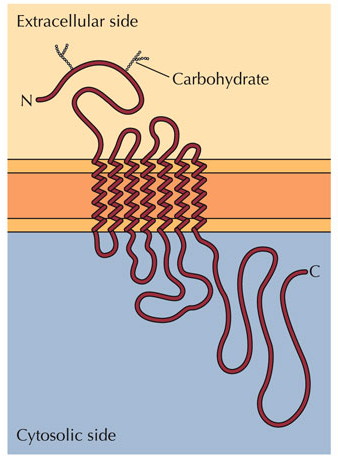 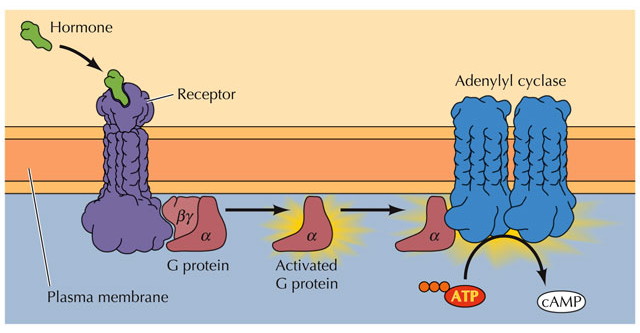
- G Protein-Coupled
Receptors: This is
the largest family of cell surface receptors.
These are multiple-pass membrane proteins (7
times). When the signal molecule binds to the G
protein-coupled receptor, the the protein
undergoes a conformational change on the cytosolic
side that causes G protein (on the cytosolic side)
to release its GDP and exchange it for GTP. The
alpha chain of G protein is therby released and
can interact with adenylyl cyclase to form cAMP
from ATP. cAMP (second messenger) then travels
within the cell and elicits further responses. (Blood
vessel
growth into brains of mice and G-protein)
- There may be as
many as 1,000 types of GPCRs encoded by the
human genome. Examples include receptors which
bind epinephrine and prostaglandins. Also, a
large percentage of the GPCRs encode olfactory
receptors and GPCRs in taste cells mediate the
bitter and sweet responses. Behavioral and mood
regulation involves GPCRs in the mammalian
brain that bind several different
neurotransmitters, including serotonin,
dopamine, GABA, and glutamate.
|
- Receptor
Protein-Tyrosine Kinases and Cytokine Receptors
and Nonreceptor Protein-Tyrosine Kinases
|
|
- Intracellular Signal Transduction: cAMP
and Others
- As seen above, signal
molecules like hormones may cause an increase in
intracellular cAMP (second messenger)
concentration by activating adenylyl cyclase. cAMP
may then activate protein kinase A (C in the
figure).
- Protein kinase
phosphorylates proteins, in some cases activating
them and in other cases inactivating them.
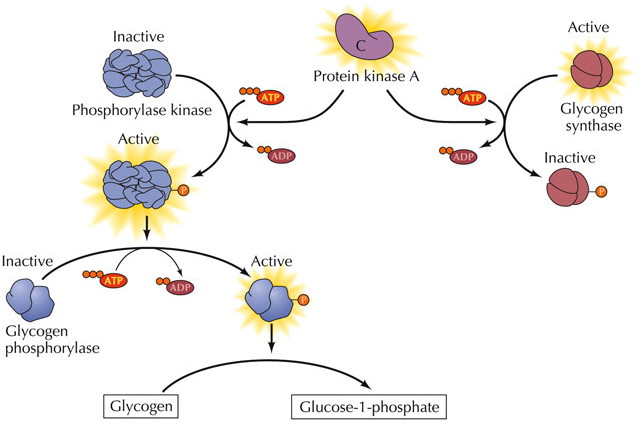
- Protein
kinase may also enter the nucleus and activate
transcription.
- Exosomes
Case Study: Angiotensin,
angiotensin-converting enzyme (ACE), angiotensin
receptors (AT1, AT2), and ACE inhibitors:
AT1 and AT2 are G protein-coupled receptors.
- What is angiotensin?
- What does it bind to?
- What are the sequence of events resulting from
its binding and the overall consequence?
- What specifically do ACE inhibitors do and what
is their overall effect?
|
 Home
Home
